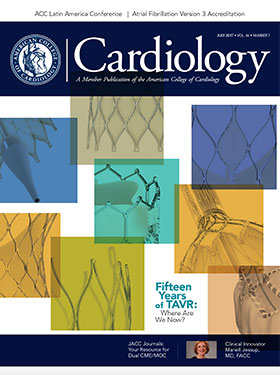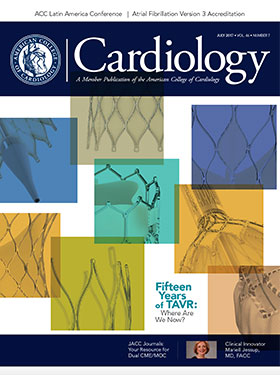PARTNER I: Five-Year Echo Outcomes after TAVR in High Risk, Inoperable Aortic Stenosis


In this ACCEL interview, Deepak L. Bhatt, MD, MPH, FACC, is joined by Pamela S. Douglas, MD, MACC, to talk about results of the PARTNER I five-year echo outcomes and the long-term hemodynamic and structural outcomes after transcatheter aortic valve replacement (TAVR) in patients with aortic stenosis (AS) who are at high risk or are inoperable.
Dr. Bhatt: What was the objective of the PARTNER I echo study?
Dr. Douglas: The PARTNER study was the first and largest of TAVR conducted in the U.S. It began in 2007 and enrolled over 3,000 patients. All patients have been followed to five years for survival. This allowed us to follow each patient with echocardiography via a single core lab, providing an incredibly unique and rich resource to examine the hemodynamic durability of these new transcatheter heart valves.
This is very important, because, as the field of TAVR is exploding, we need to know how the valves perform over time.
As we move to patients with lower levels of risk who will be living for many years with the percutaneous valve this is especially important.
What were the findings of this echo study?
We examined the data in about 2,500 patients who underwent TAVR, with more than 10,000 echos. We examined the data in two ways. First, we performed some very complex, statistically robust population modeling using non-linear mixed effects to develop an entire population trend using every single data point for the key hemodynamic variables. These were aortic valve mean gradient, Doppler velocity index and aortic valve area or effective orifice area (EOA).
Our findings for each of these variables are very interesting and we believe reasonably unique. In just a few months post implant, there were initial favorable changes for all three variables, followed by a very stable period out to five years. Thus, on a population basis, there was no evidence of valve deterioration. This is not surprising if the percutaneous valves behave in the same way as surgical valves, which are stable at five years.
Sure, although it’s important to actually demonstrate this for the TAVR valves.
Yes, absolutely. We saw the same thing in the surgical valves, including that early funny little blip in the surgical valves. I think this hasn’t been seen by others, because there have been very few vigorous core lab analyses in surgical valves before the TAVR trials.
"On a population basis, there was no evidence of valve deterioration." — Pamela S. Douglas, MD, MACC
Second, we examined the data to determine if there are any trends and if they relate to outcomes or events. This is very complicated because of looking at changes in hemodynamics at the same time patients are having events, making it difficult to determine causation. Echo findings need to change first and then an event analysis can be conducted. For each 6-month period during follow-up, for the composite endpoint of event-free survival, we compared each of the hemodynamic variables to the values for the previous six-month period in survivors and non-survivors.
In patients who had an event, mean gradients were lower than in event-free survivors. This is just the opposite of what would be seen if there was a valve problem. There was no relationship to Doppler velocity index or EOA, which is not the finding that’s expected. If there was a valve deterioration problem, patients with lower valve areas would be the ones who died.
To explore that further, we also did the same exercise for ejection fraction and stroke volume index. We found that patients with events had lower ejection fractions early on and throughout the entire trial and had lower stroke volume indices. This makes it pretty clear that the adverse events were related to underlying diseases of low output, low flow states and not to valve deterioration.
Altogether these are very reassuring data for the TAVR valves, at least out to five years in this population.
Yes, and remember that was population data. We also conducted individual case reviews of the 20 patients who had a re-intervention. The indication for re-intervention was structural or valve thrombosis in only five patients. The vast majority were for paravalvular leak or procedural complications initially or a few from endocarditis.
"In patients who had an event, mean gradients were lower than in event-free survivors. This is just the opposite of what would be seen if there was a valve problem." — Pamela S. Douglas, MD, MACC
Then we looked at the hemodynamic outliers, patients with a mean gradient change of greater than 20 or 40 mm Hg between echos. There was just a dozen patients in each group, and they didn’t have any excess events compared with the overall population.
The take-home message of our study is that it’s the largest valve study with a core lab and it had 6,500-patient years of follow-up. And it showed a very favorable hemodynamic profile with no deterioration to five years. For individual events, we did not find a relationship between valve deterioration based on study echos and adverse events.
This is great news for everyone involved with the care of TAVR patients. Did you see any evidence of the subclinical leaflet thrombosis issue that has been noted in some studies?
We didn’t. There was only one patient who had a revascularization for subclinical leaflet thrombosis out of 2,500 patients. It is possible that some of the deaths were related to that and the patient didn’t have an echo during the trial. The trial just had surveillance echos, so it may be that one was not performed in close enough proximity to an event to have detected it. It’s also possible that subclinical leaflet thrombosis may have been detected by clinical data at the sites, which did not become part of the study case report form. But we didn’t see it in our echo study. We saw a fairly large bit of variability in some of the hemodynamics like the Valve Academic Research Consortium-2 criteria in both the SAVR and TAVR patients. But when we looked at the tip of the iceberg in terms of the most severely abnormal hemodynamics, it didn’t seem to have a relationship to events. So I wouldn’t think there would be one with the more mild changes.
At five years, what gradient would be acceptable?
The average population gradient at five years was 10.3 mm Hg.
That’s pretty remarkable.
Yes, it is. We had almost 300 patients at 5 years.
Any parting thoughts?
This is incredibly reassuring. We know the performance is similar with surgical valves for this mid-term time period. We will need to look again at 10 years to see if there’s a signal for degeneration in the TAVR patients.
Is that planned as part of the study?
It wasn’t planned as part of the study and it may actually not be possible because the average age in PARTNER I was almost 85 years old. So we’re starting to talk about an average patient age of 95, and these were not healthy 85-year-olds.
"There was only one patient who had a revascularization for subclinical leaflet thrombosis out of 2,500 patients." — Pamela S. Douglas, MD, MACC
So I think that longer-term follow-up may be left to some of the intermediate risk studies or lower risk studies that are ongoing now. I think it would be wonderful if the TAVRs had the same durability as the SAVRs. Everything we can tell now with this incredibly rich data source says that they do.
At least, it seems from your study, there’s no reason not to go ahead and study these valves in lower risk patients. Obviously, the randomized trials are ongoing, but it seems like there’s no safety signal here that would make one worried about moving into lower surgical risk patients.
Exactly, and we won’t know the long-term results in the lower risk patients for another eight to ten years, because those studies are just starting to enroll.
This interview has been edited for print from a transcript.
 |
|
| Click the cover image above to read the latest issue of Cardiology in e-pub format or click here to read it on the web! | |
Keywords: ACC Publications, Cardiology Magazine, Stroke Volume, Transcatheter Aortic Valve Replacement, Aortic Valve, Aortic Valve Stenosis, Echocardiography, Endocarditis, Thrombosis
< Back to Listings

